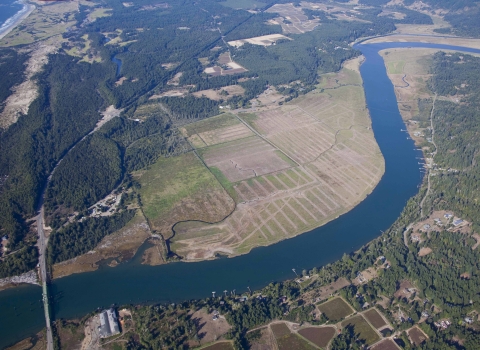Projects and Research
Biological Investigations
Many land management objectives occur at scales that can be challenging to grasp from ground level. A good aerial photograph is worth thousands of words when conveying the big picture perspective of how all the pieces of a landscape fit together.
The coastal refuges offer unique opportunities to study plants and animals in pristine or relatively undisturbed habitats. These field studies seek to answer questions ranging from the needs of a single species to how an entire ecosystem functions.
Biologists conduct innovative research in many coastal habitats, including marshes and estuaries. At Bandon Marsh NWR, the removal of dikes brought back the influence of daily tidal cycles and restored the natural hydrology of the marsh, providing ample opportunity for research.
For centuries both people and wildlife have flourished at Bandon's Ni-les'tun Marsh amid geologic and human-induced changes. Twelve times in the last 6,700 years, earthquakes shook this coastline and triggered gigantic waves called tsunamis; the last such temblor and resulting seiche, in 1700, scoured the shore and lowered the entire Coquille River delta a half-foot. More than a century...
During the restoration of the Ni-les’tun Marsh from a dairy farm to tidal wetland in 2010 and 2011, the linear drainage ditches used to keep pastures dry were filled and the marsh disked to create a more natural surface to improve habitat for fish and wildlife. Although this effectively eliminated the ditches, it also created a series of small pools that would retain water once the...
Invasive plants are one of the most frequently cited threats to biological integrity, diversity, and environmental health within the National Wildlife Refuge System because of their negative impact on habitat structure, species composition, and overall function of ecological communities. The refuge...
Researchers from Oregon State University, the Confederated Tribes of the Siletz Indians and the Institute of Applied Ecology has been collecting data on vegetation, soil conditions and accretion, water quality, and fish passage to monitor the success of the Ni-les'tun Marsh restoration project over time. The Bandon Marsh has been used as a control site for these studies. The work conducted...




